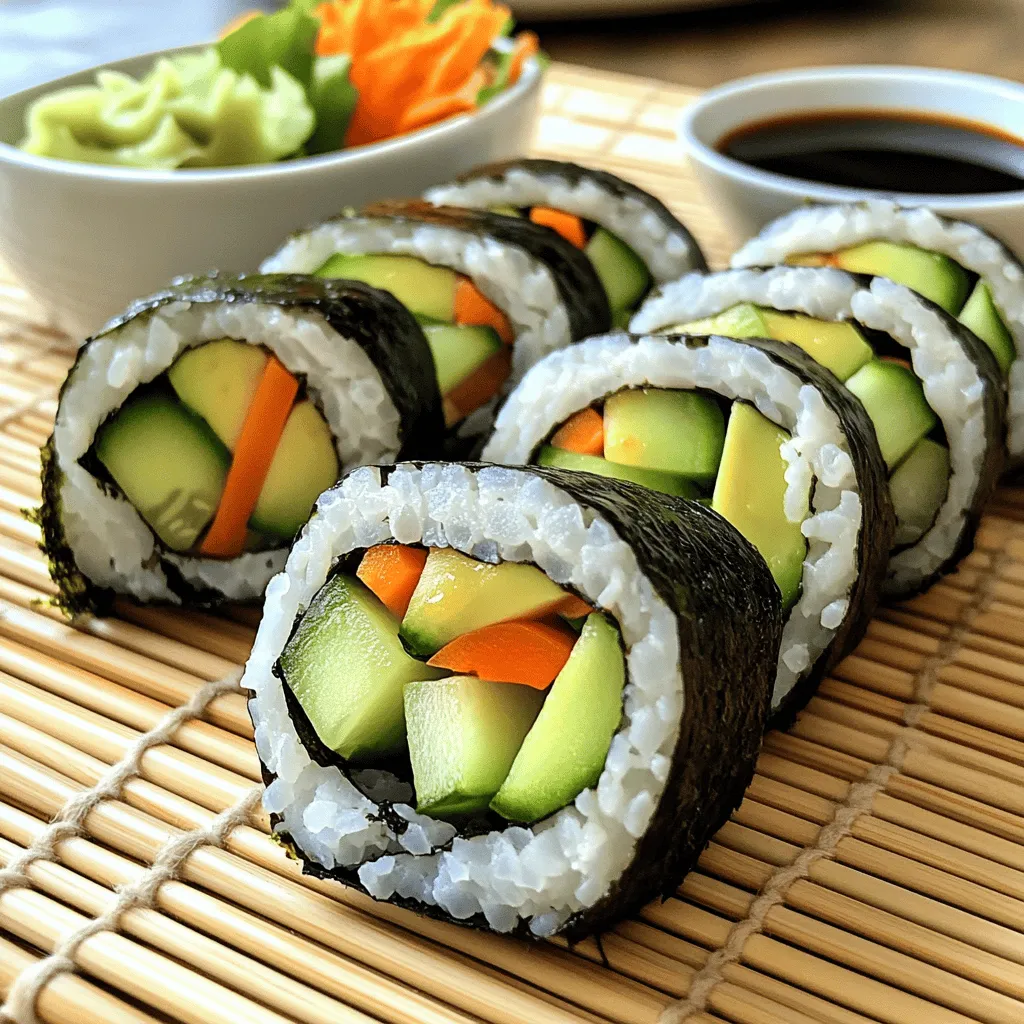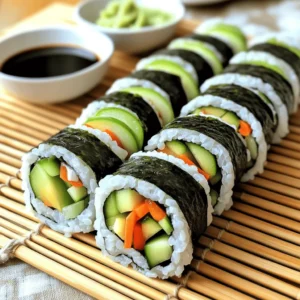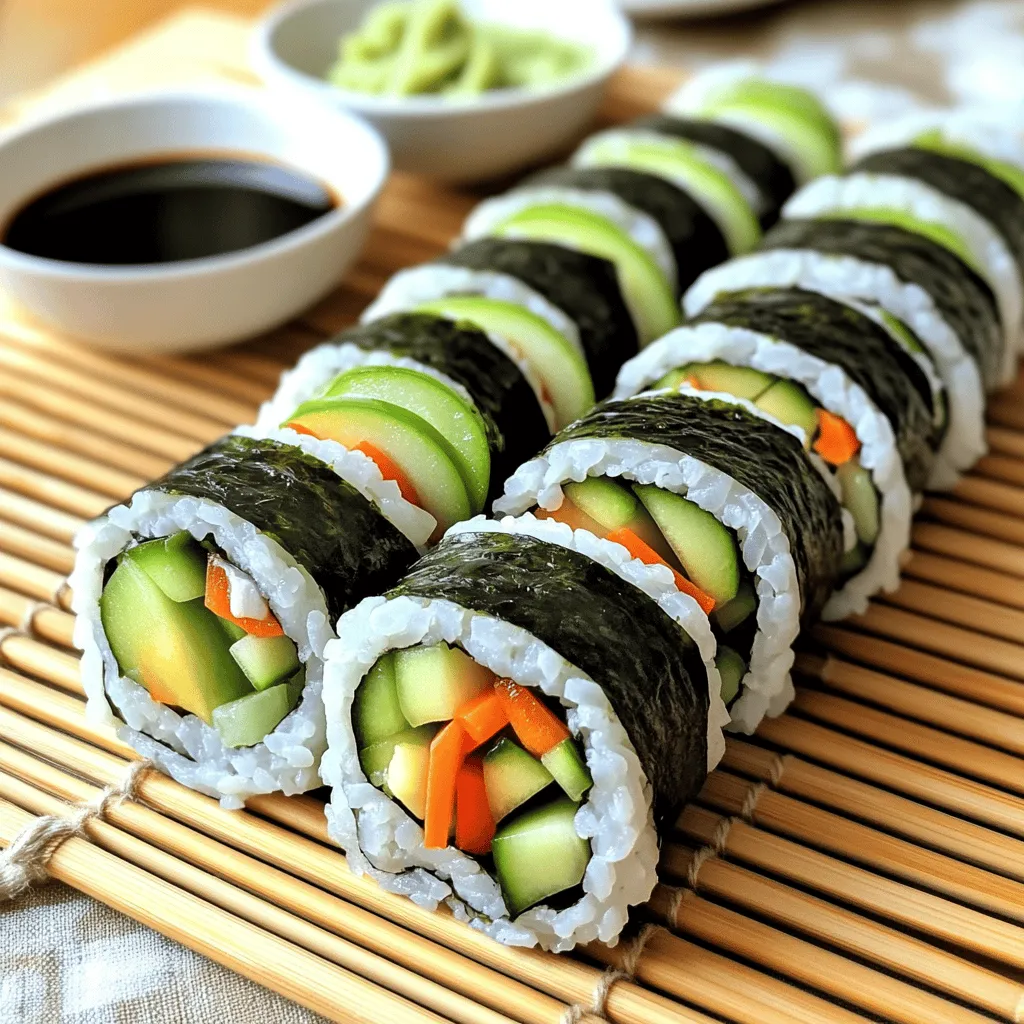Making sushi rolls at home is easier than you think! With fresh ingredients and simple steps, you can impress your friends and family. I’ll guide you through selecting the right items and mastering rolling techniques. Whether you’re a beginner or looking to sharpen your skills, these tips and tricks will make sushi night a hit. Ready to dive into the delicious world of sushi? Let’s get rolling!
Ingredients
To make sushi rolls, you need fresh ingredients. Here’s the complete list:
– 2 cups sushi rice
– 2 ½ cups water
– ½ cup rice vinegar
– 2 tablespoons sugar
– 1 teaspoon salt
– 4 sheets nori (seaweed)
– 1 cucumber, julienned
– 1 avocado, sliced
– 1 small bell pepper, thinly sliced
– 1 carrot, shredded
– Soy sauce for dipping
– Wasabi and pickled ginger (optional)
Using fresh ingredients makes a big difference in taste. Sushi rice is key for perfect rolls. Rinse it well to remove excess starch. This step helps the rice stay fluffy.
Nori sheets are the wrap. They should be crisp and dark. If they feel soft, they may be old. Fresh veggies add crunch and color. Cucumber and avocado are popular choices. They bring great flavors and textures.
When you pick a bell pepper, choose one that is firm. Thin slices work best in sushi. Carrots add sweetness and a nice crunch. For dipping, soy sauce is traditional. Wasabi and pickled ginger add spice and zing.
With these fresh ingredients, you can make delicious sushi rolls. Check the Full Recipe for detailed steps.
Step-by-Step Instructions
How to Prepare Sushi Rice
– Rinsing and Cooking Rice: Start by rinsing 2 cups of sushi rice under cold water. Keep rinsing until the water runs clear. This step helps remove extra starch. After rinsing, drain the rice well. In a medium pot, combine the rinsed rice with 2 ½ cups of water. Bring this mixture to a boil. Once it boils, lower the heat, cover the pot, and let it cook for 20 minutes.
– Seasoning the Rice: While the rice cooks, mix ½ cup rice vinegar, 2 tablespoons sugar, and 1 teaspoon salt in a small pot. Heat it gently on low. Stir until the sugar and salt dissolve completely. Once it’s ready, remove it from the heat and let it cool.
– Cooling the Rice: After the rice has cooked, let it sit covered for 10 minutes. Then, transfer it to a large bowl. Gently fold in the cooled vinegar mixture with a spatula. Be gentle to keep the rice grains intact. Let the seasoned rice cool to room temperature.
Assembling the Sushi Rolls
– Setting Up Your Rolling Mat: Lay a bamboo sushi rolling mat on a clean, flat surface. This will help you roll your sushi with ease.
– Adding Fillings to the Nori: Place a sheet of nori, shiny side down, on the mat. With wet hands, spread about 1 cup of sushi rice over the nori. Leave a 1-inch border at the top. This space will help seal the roll later.
– Rolling Technique: In the center of the rice, lay a line of fillings. You can use julienned cucumber, sliced avocado, thin bell pepper, and shredded carrot. Starting from the bottom, lift the edge of the mat. Gently roll the sushi away from you, keeping the filling in place. Tuck the edge of the mat tightly as you roll. Moisten the top edge of the nori to seal the roll.
Final Steps for Serving
– Slicing the Rolls: Take a sharp knife and slice the rolled sushi into bite-sized pieces. Clean the knife with a damp cloth between cuts for neat edges.
– Presentation Tips: Arrange the sushi rolls on a decorative plate. You can present them in a circular pattern. Add small bowls of soy sauce, wasabi, and pickled ginger in the center for a beautiful display.
For the full details on this process, check out the Full Recipe and get ready to impress your friends and family!
Tips & Tricks
Common Mistakes to Avoid
Overcooking Sushi Rice
Cook your sushi rice for exactly 20 minutes. If you cook it longer, the rice can become mushy. This will ruin the texture of your rolls. Always check the water level during cooking. Once the water is absorbed, let it sit off the heat. This helps the rice steam and become fluffy.
Incorrect Rolling Technique
Rolling sushi can be tricky. Start at the bottom edge of the mat. Tightly roll away from you while keeping the filling in place. If you roll too loosely, your sushi will fall apart. Make sure to seal the edge with a bit of water to keep everything together.
Essential Tools for Sushi Making
Bamboo Rolling Mat
Using a bamboo mat is key for making sushi rolls. It helps you shape the rolls evenly. Place the nori on the mat with the shiny side down. This mat provides the right support to roll tightly and evenly.
Sharp Knife
A sharp knife is essential for cutting sushi. A dull knife will squish your rolls and ruin their shape. Clean your knife with a damp cloth after each cut. This keeps the edges neat and helps maintain a beautiful presentation.
Enhancing Flavor and Presentation
Suggested Dipping Sauces
Soy sauce is the classic dip for sushi rolls. You can also mix soy sauce with a bit of wasabi for a kick. If you like something sweeter, try a teriyaki sauce. You can create your own blend by mixing soy sauce with sesame oil.
Garnishing Ideas
Garnish your rolls for a pop of color. Use thinly sliced radishes or sprouts for freshness. A sprinkle of sesame seeds adds a nice crunch. Arrange your rolls on a plate with colorful garnishes. This makes the dish look inviting and fun.
For the full recipe, check out the detailed instructions provided.

Variations
Popular Filling Alternatives
Meat and Seafood Options
You can use many meats and seafood for sushi rolls. Here are some tasty choices:
– Crab meat
– Cooked shrimp
– Grilled chicken
– Spicy tuna
– Salmon
These options add great flavor and protein to your rolls. You can mix and match these fillings to suit your taste.
Vegetarian Choices
If you prefer veggies, there are many great options too. Try these fillings:
– Cream cheese
– Tofu
– Sweet potato
– Mango
– Asparagus
These ingredients give you a colorful and fresh sushi roll. They taste amazing and are filling, too.
Different Types of Sushi Rolls
Maki vs. Temaki
Maki rolls are the most common type. They are round and cut into pieces. You roll them tightly with nori on the outside. Temaki rolls are hand rolls. They look like cones. You fill and roll them by hand, making them fun to eat.
Inside-out Rolls
Inside-out rolls have the rice on the outside. This style is popular in many sushi bars. It allows for creative toppings. You can sprinkle sesame seeds or add avocado on the outside. This gives a nice texture and look.
Spicy and Unique Flavor Combinations
Adding Spices
Want to spice things up? You can add sriracha or chili flakes to your fillings. This adds heat and exciting flavors. Try mixing these spices with mayonnaise for a creamy kick.
Incorporating Sauces
Sauces can elevate your sushi rolls. Here are some ideas:
– Eel sauce for sweetness
– Soy sauce for saltiness
– Ponzu sauce for a citrusy twist
These sauces can enhance the flavors in your rolls. Just drizzle them on top or serve them on the side for dipping.
Storage Info
How to Store Leftover Sushi Rolls
To keep leftover sushi rolls fresh, wrap them tightly in plastic wrap. This keeps air out and helps retain moisture. Place the wrapped rolls in the fridge. Try to eat them within 24 hours for the best taste.
For reheating, do not use the microwave. Instead, let the rolls warm up to room temperature. This helps the rice regain some of its original texture.
Shelf Life of Sushi Rolls
Sushi rolls taste best when fresh. If stored correctly, they can last about one day in the fridge. After that, the rice and fillings may lose flavor and texture.
Signs of spoilage include a sour smell, a slimy texture, or discoloration. If you notice any of these signs, it’s best to throw them away.
Sushi Roll Ingredients Storage
Storing fresh vegetables is key. Keep them in a cool, dark place or the fridge. Wrap them in a damp paper towel to help them stay crisp.
For nori, keep it in a cool, dry place. Use an airtight container to keep it fresh. If nori gets too soft, it won’t roll well. Always check the package for the best storage tips.
To get the full experience of making sushi rolls, check out the Full Recipe.
FAQs
What is the best rice for making sushi?
The best rice for sushi is sushi rice. It is short-grain and sticky. This type helps the rolls hold together. Look for brands labeled “sushi rice” or “shari.”
Can I make sushi rolls without rice?
Yes, you can make sushi rolls without rice. You can use thinly sliced vegetables or fruits instead. Options like cucumber or zucchini work well. These rolls are fresh and low-carb.
How do I prevent the rice from sticking?
To prevent rice from sticking, rinse it well before cooking. This step removes excess starch. Use wet hands when handling the rice. This also helps keep it from sticking.
Can sushi rolls be frozen?
Sushi rolls can be frozen, but with caution. Freezing may change the texture of the ingredients. It’s best to freeze plain rolls without vegetables or seafood. Wrap them tightly before freezing.
What is the difference between sushi and sashimi?
Sushi includes rice and toppings, while sashimi is just raw fish. Sushi is a complete dish, while sashimi focuses on the fish itself. Both are delicious and popular in Japanese cuisine.
How do I make sushi rolls more flavorful?
To enhance flavor, add sauces or seasonings. Try using soy sauce, spicy mayo, or sesame oil. Adding herbs like cilantro or mint can also boost taste. Experiment with different combinations for fun. For a complete guide to making sushi, check the Full Recipe.
Making sushi rolls at home is fun and easy. You learned about the needed ingredients, how to prepare and roll sushi, and tips to avoid mistakes. I shared common variations and storage tips to keep your sushi fresh.
Now, you have all the tools and knowledge to create delicious sushi rolls. Get creative with flavors and fillings. Enjoy your sushi-making journey!

